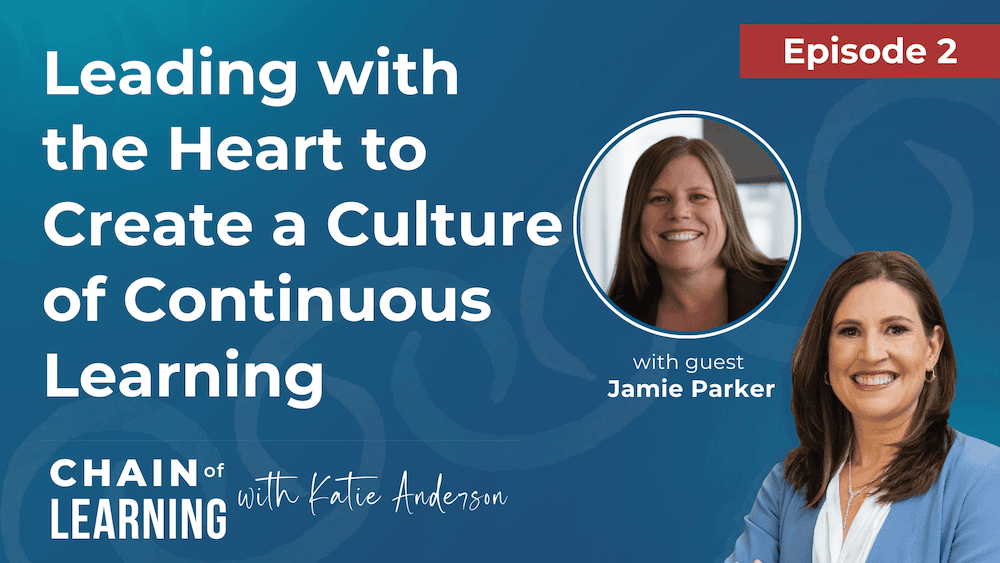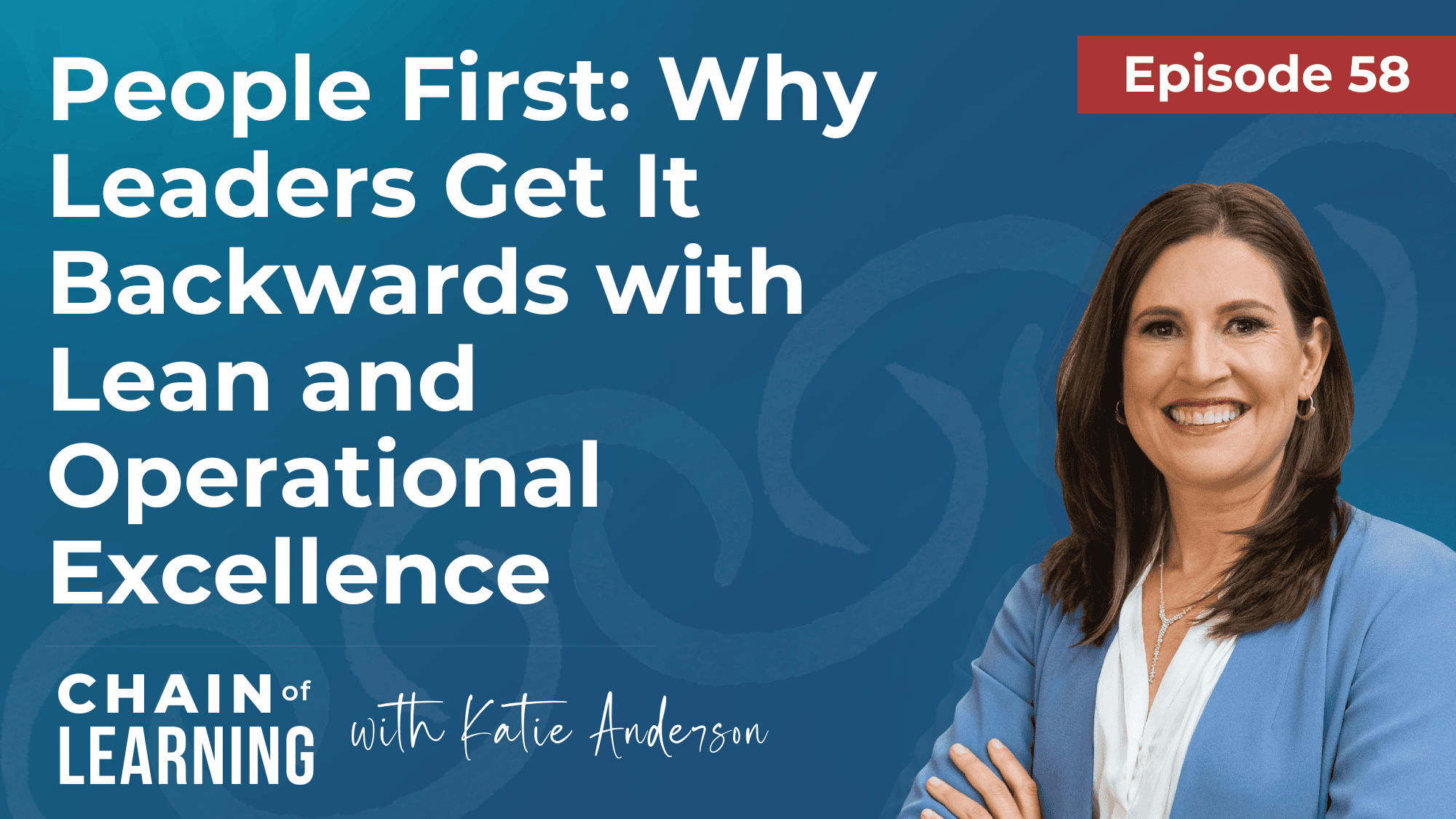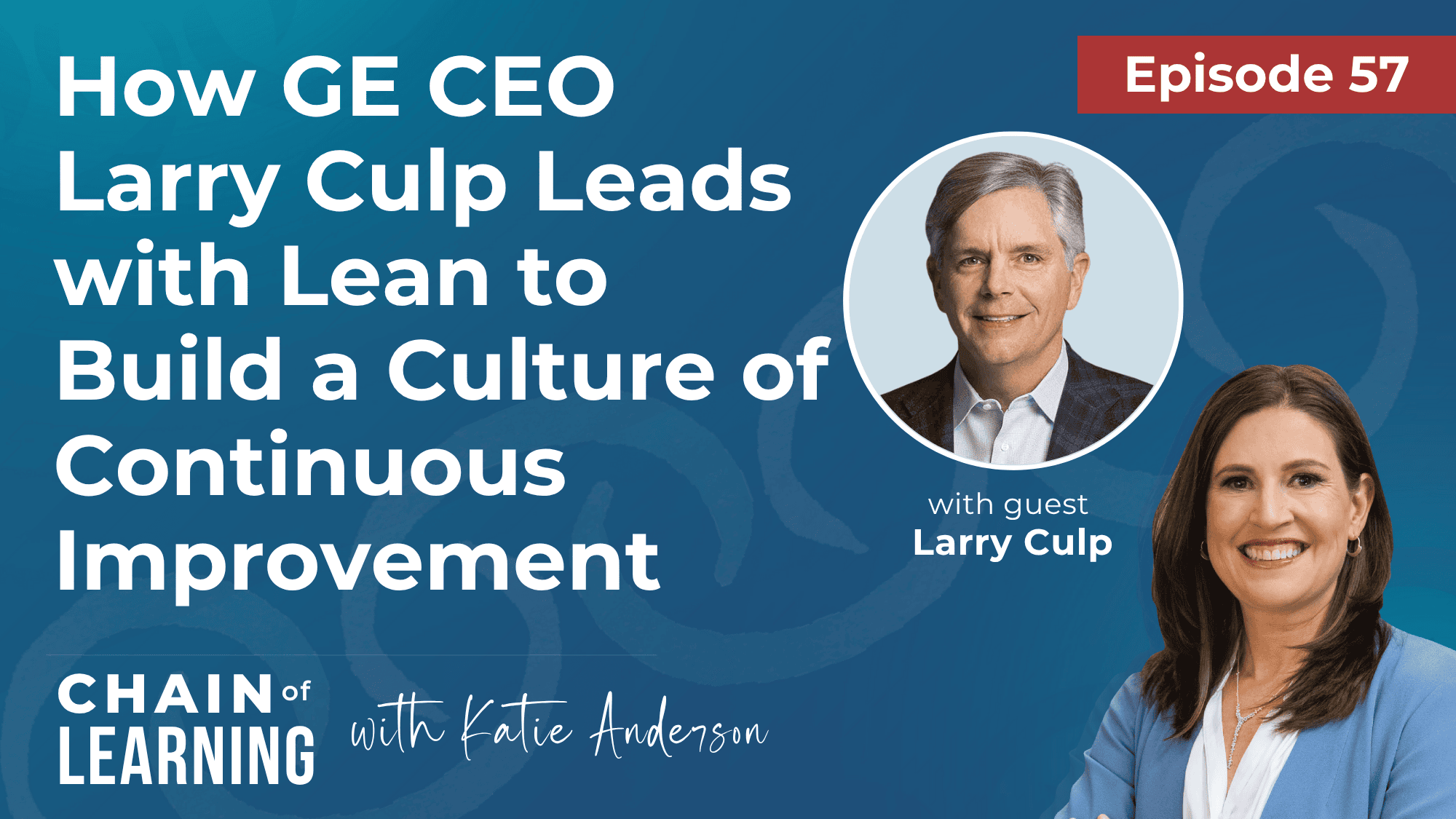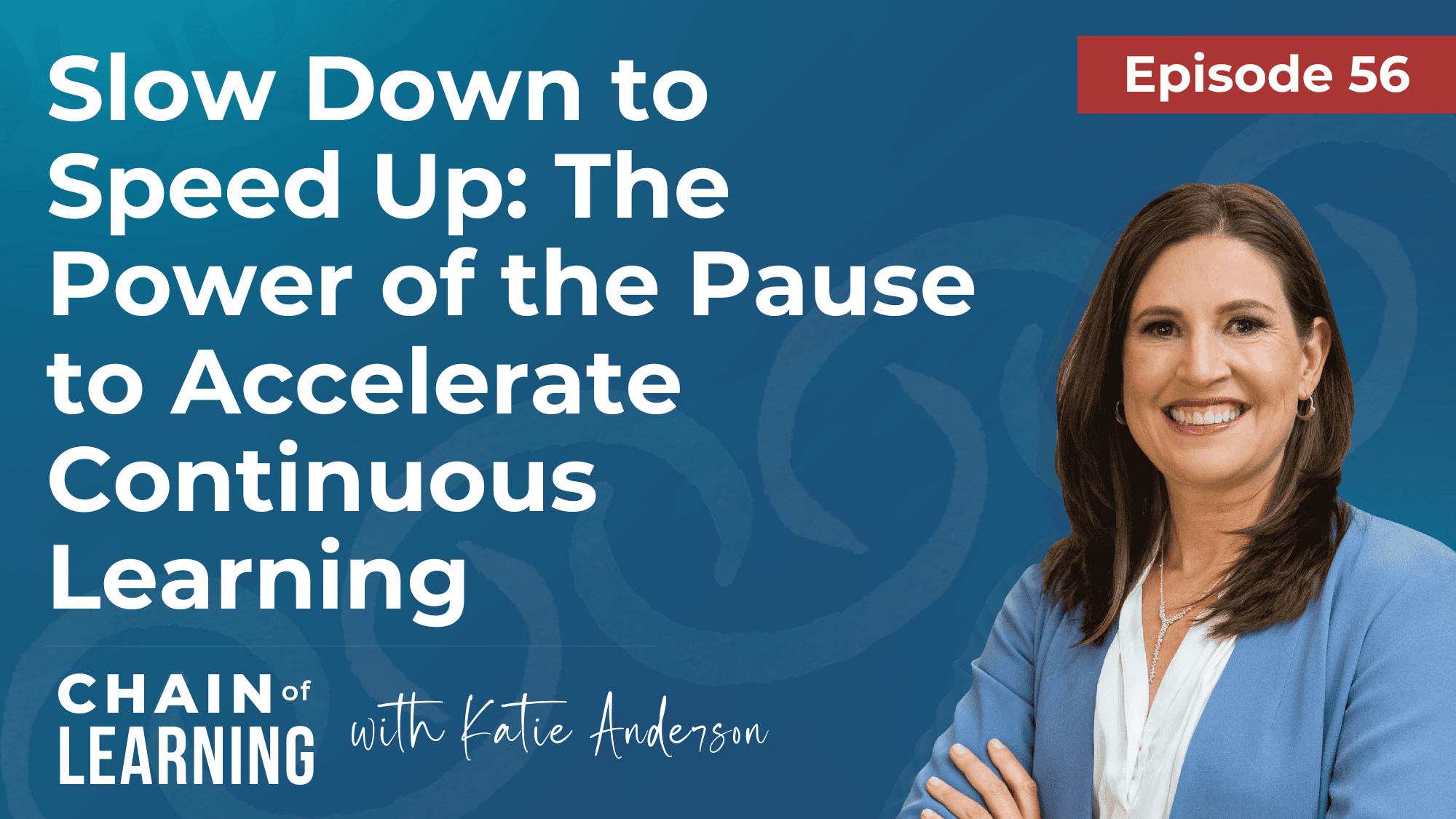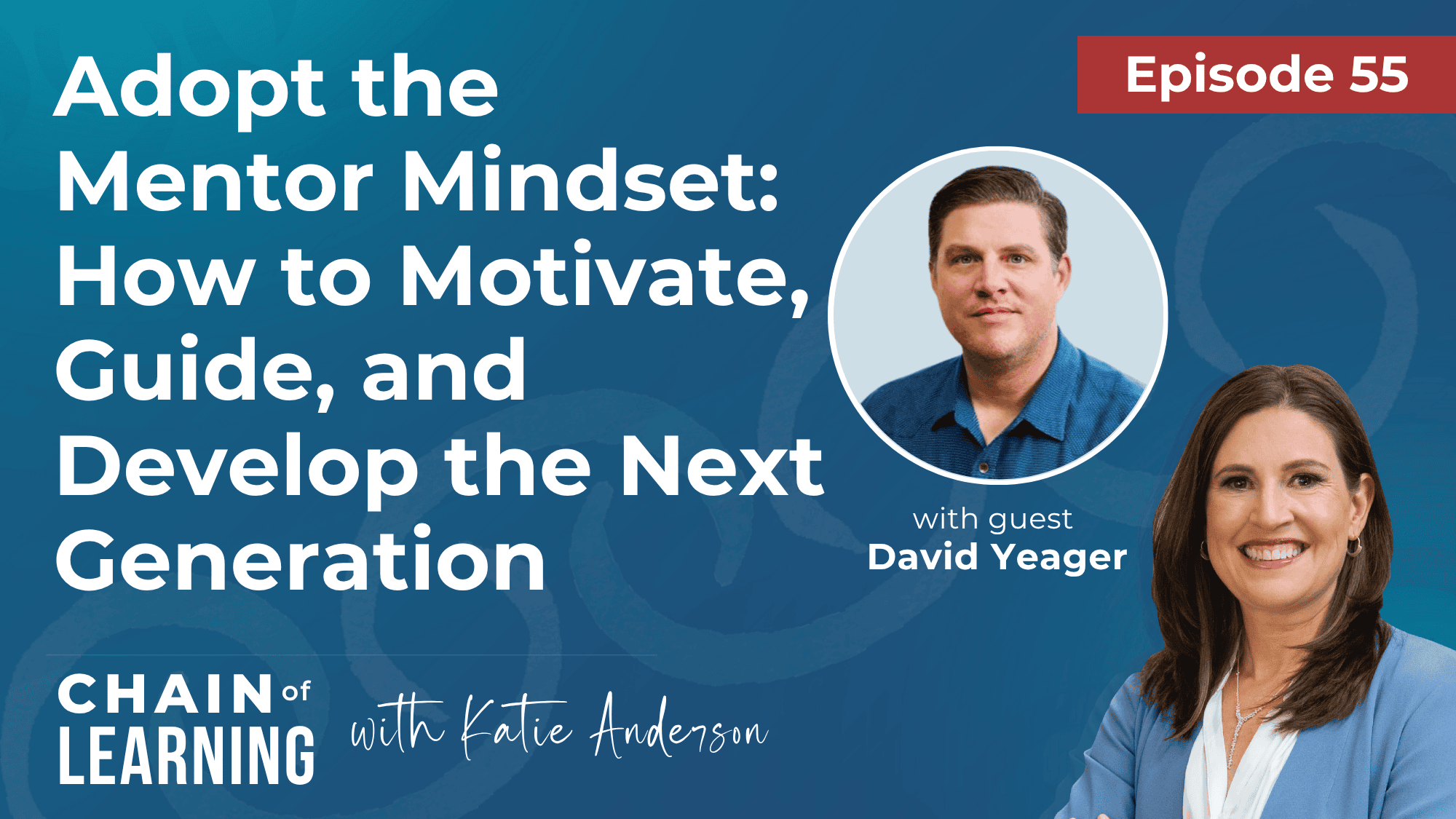Encouraging a Growth Mindset and Human Connection in High-Performance Organizations
What does it really take to create a thriving organization – one that is not just focused on delivering results, but doing so by engaging people’s minds and hearts to collaborate, innovate, and solve problems as the way to get to those results?
If you’re trying to create a culture of operational excellence and continuous improvement: What’s love got to do with it? As Jamie Parker and I explore here – a lot!
Love, empathy, and human connection is our focus on this episode of Chain of Learning.
And you just might walk away singing a little Tina Turner too.
Can We Be People-Centered Without Being Heart-Centered?
You’ve likely heard the idea that organizations thrive when they are people-centered. You are likely a proponent of engaging people in your organization.
But here is a question to ask yourself, can you be people-centered without being heart-centered?
In this episode of Chain of Learning, I talk with Jamie Parker and continue our conversation about our takeaways from GE’s The Lean Mindset event and how it relates to leadership and cultures of continuous improvement (part one of which you can hear on her podcast Lean Leadership for Ops Managers – Episode 125 – Developing a Growth Mindset as a Leader).
Here, we explore the concept of heart-centered leadership. We dive into the benefits and challenges of leading with love and empathy. We discussed the importance of listening and going to see. And, we look at how human connection is the foundation for a culture of continuous improvement – and ultimately for achieving results.
Some of these things may seem obvious to you – yet some might seem foreign – as a way to lead a team and inspire an organizational culture.
I can promise you that after you listen to this episode, you’ll be looking at love and emotions at work in a whole new light.
What you can expect to take away from this episode:
✅ The value of sharing struggles and challenges to foster a culture of learning
✅ Our key takeaways from GE’s The Lean Mindset event, including hearing from leaders like GE CEO Larry Culp, PG&E CEO Patti Poppe, Ford CEO Jim Farley, Chef Wolfgang Puck, basketball superstar Giannis Antetokounmpo, Professor Carol Dweck, and many more
✅ How leading from the heart, with love and empathy, makes us more effective leaders
✅ How to more effectively listen and Break the Telling Habit®
✅ That a focus on people is the way to achieve results.
Tune in now!
Tune in now to discover how you can bring more love, empathy, and human connection into your leadership approach to engage your people, get better results, and build a culture of continuous learning.
Watch the whole conversation between Katie Anderson and Jamie Parker
You can watch the entire conversation between me and Jamie Parker in the YouTube video link below.
In the first half of conversation, which Jamie released on her podcast, Jamie and I explored how to develop a growth mindset as a leader or individual, including how:
✅ Change Begins with Leadership
✅ Differences Between Fixed and Growth Mindset
✅ Growth Mindset is the Foundation of Continuous Improvement
✅ A growth mindset helps us step into something new
And then we move into the conversation available on this podcast episode of Chain of Learning.
Watch the full conversation now!

Linking Podcasts About Learning and Leading
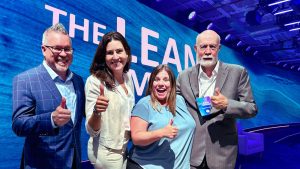 For some context about this episode – In September, Jamie, Mark Graban, and I were invited by GE to attend their Lean Mindset event in New York City and to capture our reflections and interview leaders for our podcasts. You can read more about my initial reflections from the event here.
For some context about this episode – In September, Jamie, Mark Graban, and I were invited by GE to attend their Lean Mindset event in New York City and to capture our reflections and interview leaders for our podcasts. You can read more about my initial reflections from the event here.
I was honored that my book Learning to Lead, Leading to Learn was one of the handful of books chosen by Larry Culp to give to attendees to deepen their understanding about the human side of lean and continuous improvement.
At dinner together after the event, Jamie and I brainstormed the idea of doing two cross-over podcast episodes – linked podcast episodes – as a way to share reflections embody this Chain of Learning concept – and celebrate the launch of Chain of Learning.
This episode of Chain of Learning is the second half of a two part-conversation that Jamie and I had about GE’s recent event, The Lean Mindset: The Pursuit of Progress.
You can catch the first part – that began in Episode 125 on Jamie’s podcast “Lean Leadership for Ops Managers”– and now continues here.
This conversation is truly a “chain of learning” linked between our two podcasts!
About My Guest: Jamie Parker
Jamie Parker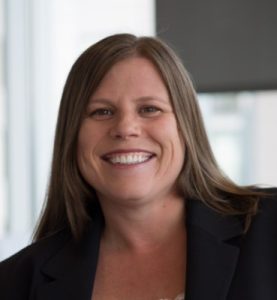 is the trusted partner for operational leaders and manufacturing executives seeking to create a high-performance culture and transformational growth, and has been a close friend of mine since we met a half-decade ago. Prior to founding her consulting business, Process + Results, Jamie was a senior leader at FedEx for over 15 years.
is the trusted partner for operational leaders and manufacturing executives seeking to create a high-performance culture and transformational growth, and has been a close friend of mine since we met a half-decade ago. Prior to founding her consulting business, Process + Results, Jamie was a senior leader at FedEx for over 15 years.
Jamie explains more about how we met and have collaborated in the introduction to the first part of this conversation in Episode 125 of the Lean Leadership for Ops Managers Podcast.
I’ve also been a guest several times on Jamie’s podcast “Lean Leadership for Ops Managers” – see notes below for links to these episodes and more.
Jamie’s Website: Process + Results
Connect with Jamie on Process + Results
Important links
- Listen to the first part of mine and Jamie’s discussion on Lead Leadership for Ops Managers podcast episode 125: Developing a Growth Mindset as a Leader with Katie Anderson
- Watch GE’s The Lean Mindset Event videos
- See Katie’s key takeaways from The Lean Mindset event
- Listen to my discussion with Jamie Parker, Mark Graban, and Jim Womack about GE’s The Lean Mindset event
- Watch the full discussion between Jamie and me on YouTube
- Listen to: Breaking the Telling Habit with Katie Anderson and Jamie Parker | Episode 104 of the Lean Leadership for Ops Managers Podcast
- Listen to: Collaboration, Not Competition with Tracy O’Rourke, Katie Anderson, and Jamie Parker | Episode 095 of the Lean Leadership for Ops Managers Podcast
- Listen to: Intentional Leadership with Katie Anderson and Jamie Parker | 021 of the Lean Leadership for Ops Managers Podcast
- Follow me on LinkedIn
- Follow Jamie on LinkedIn
- Read my book: Learning to Lead, Leading to Learn
Subscribe to Chain of Learning
Don’t miss the next episode! Subscribe or follow now on your favorite podcast player.
Share this episode with your friends and colleagues so we can all strengthen our Chain of Learning® – together!
Timestamps for this episode
00:01:35: Introduction of Jamie Parker
00:01:52: Discussion about GE Lean Mindset event
00:04:23: Tips on fostering growth and continuous improvement mindset
00:08:52: Leading with love and empathy
00:11:03: Challenge for the listeners
00:14:05: Leading with intention
00:18:05: The role of emotion and love in the workplace
00:20:29: Reflection on the conversation and event
00:20:59: Launch of the Chain of Learning podcast
00:21:41: Introduction to Jamie’s podcasts and the importance of subscribing
00:22:02: Post event discussion with Mark Graben and Jim Womack
00:22:41: Reflecting on empathy and human connection in leadership
00:22:57: Subscribe to Chain of Learning podcast
00:23:09: Preview of episode three with professor Carol Dweck
Full Episode Transcript
Katie Anderson: If you’re trying to create a culture of operational excellence and continuous improvement, what’s love got to do with it? As Jamie Parker and I explore today on chain of learning a lot. Love, empathy and human connection is our focus, and you just might walk away singing a little Tina Turner too. Welcome to Chain of Learning, where the links between leadership and learning unite. This is your connection for actionable, strategy and practices to empower you to build a people centered learning culture, get results, and expand your impact so that you and your team can leave a lasting legacy.
Katie Anderson: I’m your host and fellow learning enthusiast Katie Anderson. What does it take to really create a thriving organization, one that’s not just focused on delivering results, but doing so by engaging people’s minds and hearts to collaborate, innovate and solve problems as the way to get those results? My friend and colleague Jamie Parker joins me here to share with you the second half of what is a two part conversation that she and I had about the recent GE Lean Mindset event that first began on Jamie’s podcast, Lean Leadership for Ops Managers and now continues here. This conversation is truly a chain of learning linked between our two podcasts. Tune into this episode to learn how you can leverage human connection, empathy and yes, love to more effectively lead, coach, and create high performing organizations.
Katie Anderson: Jamie Parker is the trusted partner for operational leaders and manufacturing executives seeking to create a high performance culture and transformational growth. Jamie explains more about how we met and have collaborated in the introduction to the first part of this conversation in episode 125 of the Lean Leadership for Ops Managers podcast. I encourage you to check it out after listening here and all the details are in the show. Notes for some context. In September, Jamie and I were invited by GE leaders to attend their Lean Mindset event hosted by GE CEO Larry Culp in New York City, along with GE’s key leaders, investors, suppliers and other thought leaders.
Katie Anderson: The purpose of the event was to highlight the importance of a lean and continuous improvement mindset and to go into the people side of lean across multiple industries and disciplines. Larry Culp and other GE executives speaking at the event emphasized that leading with a Lean Mindset is how GE will achieve success. It was an incredible day of hearing from global leaders all talk about how they personally lead with a continuous improvement mindset and how they cultivate it in their teams and organizations. The lineup included top executives from companies like GE, PG, E, Ford and Uber to some of the world’s most successful professional athletes and other successful leaders from healthcare service industries and academia such as Wolfgang Puck and Professor Carol Dweck. Some of the speakers might not have previously known the word lean, but they all clearly led and lived with a Lean Mindset.
Katie Anderson: GE’s made the videos from the Lean Mindset event available publicly, so be sure to check them out in the show. Notes I was honored that my book Learning to Lead, Leading to Learn was one of the handful of books chosen by Larry Culp to give to attendees to deepen their understanding about the human side of Lean and continuous improvement. At dinner after the event, Jamie and I brainstormed the idea of doing these two crossover podcasts like Linked episodes in a chain as a way to share reflections and really embody this chain of learning concept and to celebrate the launch of my podcast Chain of Learning. After you listen to this episode, be sure to tune in to the first part of our conversation on Jamie’s podcast, Lean Leadership for Ops Managers, episode 125, where Jamie and I started the conversation on how to develop a growth mindset as a leader or individual. On Jamie’s podcast, we talked about how change begins with leadership, the differences between a fixed and a growth mindset, and how a growth mindset is the foundation of continuous improvement and is what helps us step into something new.
Katie Anderson: We pick up the conversation here on Chain of Learning as we move the conversation from personally developing a growth and continuous improvement mindset into how to create organizational change and impact by leading with the heart and emotions to create a growth mindset in our organizations. We start the discussion here with a tip from me about how to create greater human connection and foster this growth and continuous mindset in our teams and organizations. Let’s dive in. One of the best ways that we’ve been talking about Jamie, you and I together, but also Carol Dweck and others mentioned in their talks at the Lean Mindset event was when we can share those struggles that we have. Both like sharing that we’re trying something new.
Katie Anderson: So that creates some humility, like, hey, I’m not perfect as the continuous improvement coach or as the operations leader, so I’m trying something new. But also sharing those struggles like this is really hard for me. And when we can share those real struggles and as you’ve talked about, it’s not just something far in the past, but something like relatable in the now, we actually create greater human connection and show that it’s okay to not be perfect. And so that we are trying to foster this growth mindset, the continuous improvement mindset, because we have to be okay with the struggle and the challenge and being imperfect.
Jamie Parker: Speaking, you’re talking about sharing struggles and how that can kind of create this environment for others. You’re really creating this space for empathy and for this human connection and for an ability for people to have a safe space for them to step in to the growth that they want to work on as well. And so now we’re really talking about something that’s not just about me, it’s really about kind of this broader organization, this broader team, and the way that we can serve others through that.
Katie Anderson: The focus on the technical side of problem solving and the outcomes and even the process to get to those outcomes is a really important part of Lean. But what I really appreciated about this GE Lean Mindset event is that it actually was focusing much more on that human side and hearing executives and leaders in different fields talking about not just the head part of continuous improvement, but really about the heart part. And we heard words like love and empathy and respect and connection as core words and guiding principles for these executives of very large organizations, be they multinational corporations or sports teams from all parts of that. So let’s shift a bit into this. How do we create an organization that’s thriving, that’s really people centered and learning?
Katie Anderson: And how do we do that from leading with the heart as well?
Jamie Parker: I just recorded a podcast about safety in this exact conversation here, which was this idea of love and empathy and care for others and how it shows up in safety. And so when you think about some of the comments from Commissioner Kavanaugh of the New York City Fire Department or Patty Poppy from PG E, as they were talking know, when we talk about safety, they’re like, hey, I signed up for this, I knew the risks, I signed up for it, I’m good. But when they shift that conversation to say, but this is safety is about the safety of your teammate or the safety of your customer, the safety of your provider, that now all of a sudden this is different because now it’s not about me and what risk I signed up for. Now it’s about other people. And so the care and passion and interest that people now go to safety with is completely different because we’ve shifted that focus to be about other then that can be like a great expression of love and care is to keep people safe.
Katie Anderson: Yes, absolutely. And Poppy was talking about bringing love to work and she’s like, well, some people are a little uncomfortable with that word love, but it’s really to that human connection where we are not just thinking of self, but we’re thinking of others as well. And that can go into that component of we’ve talked earlier about creating empathy and if when we share our struggles and our own challenges, we’re moving from sympathy to true empathy. Like, I really understand the challenges, maybe not your specific challenge, but the experience of having know the CEO of Ford said you cannot delegate the impact of empathy. You have to authentically show up that way, truly caring and being empathetic from a human side.
Katie Anderson: I loved hearing these things like words about love and empathy and showing up. And he went on to say that talking about respect and how going to Sea or going to Gemba is the most important physical act of respect that you can do. And that’s when he went on to talk about and how do you show empathy while you’re going to sea? And I think back to some of my conversations with Toyota leader Isa Yoshino, who’s the subject of my book, Learning to Lead, Leading to Learn, and he’s always talked about, you don’t just go to Gemba, go to the place the work happens to check on the process and the results, which, of course, is an important part. You want to see validate what’s actually happening, but you go see to show that you care.
Katie Anderson: And the way you show that you care is by expressing genuine empathy.
Jamie Parker: Yeah. And really, to be able to do that, you have to be able to listen, right? Yeah. Which is not easy all the time.
Katie Anderson: No, it is not. Dana, the CEO at Uber, said listening is underappreciated skill because it’s so easy. How many times we ask those questions. You and I have talked about this on past podcast recordings. When I’ve come on to your show about if we don’t even pause and we just keep barreling on, we’re not really showing that we care.
Katie Anderson: We’re kind of just going through the motions, and we end up ticking the box of, yeah, I went to see, but I didn’t really listen. I didn’t really show that I cared. I didn’t really take the time. I was just doing it because I needed to do it.
Jamie Parker: Yes. And it’s hard for me because I’m impatient at times, and I’m like, I’ve got things to do. And I think for a lot of people, that’s what they experience. Like, I got things to do. I’m here for this conversation because I’m trying to achieve something.
Jamie Parker: There’s something I’m here to do, I need to get it done, and then I’m ready to move on. If you want to actually listen, it just doesn’t work that way. It means that we do have to slow down. And it’s not about me and what I’m trying to achieve right now as much as it’s about this other person and really hearing and listening to understand, which I think is a skill that you can practice and learn and get better at. Like, if you want to, you can get better at that.
Jamie Parker: It is a skill you can learn and improve on.
Katie Anderson: Yes. So everyone listening. I challenge you to ask an open ended question and then count to ten and give the space for someone to answer. Because we’re so used to ask a question, if someone doesn’t immediately say something, we move on or jump in with our own ideas or just think they don’t have something to say. But people need time to one process and then think, experiment with that and really practice with intention.
Katie Anderson: You can build this listening skill, for sure.
Jamie Parker: And the great thing is, as you learn to listen right. As we listen. So we can use these types of techniques to get better at it. Then we can really understand and hear the other person understand where they’re coming from, which is what enables that empathy to come into play. Because it’s really hard to be empathetic if you don’t actually understand where the person is coming from.
Katie Anderson: And that also requires us to check our assumptions. So what we’re expecting them to say or what they quote unquote should be saying, or even if we think we know the answer, kind of just listening into the voice in our own head. And this is something I’ve really been working with not just operational executives, but also people in continuous improvement, performance improvement, coaching and consulting roles because they’ve also been trained to have the right answer and be really great at problem solving. Sometimes they’re assigned a project to go in and like okay, I’m going to just go execute on this project. But really, if you’re not bringing people along and really the people who are doing the work, really hearing what they have to say and their challenges and their ideas too, ultimately your idea might have some success but it’s not going to sustain.
Katie Anderson: And so we all have to get better at listening and really helping create that engagement and contribution to solving the problems.
Jamie Parker: And I think the other thing question too is so how else do we serve and love on these people, right? Like on the people that we work with day in and day out? What are other ways to do that? And it’s not always getting to the right answer, the fastest way, solving the problem with the best solution in the fastest manner. A lot of times really, if we really love people and want them to grow and to learn and to experience the pride themselves, right?
Jamie Parker: If we want that to happen, we have to step back and create space to do that, which can be so hard to do because we got stuff to get done, we want to get these things done, we got to move on. But if we don’t sometimes create that space and create the opportunity for others, then are we really serving them and giving them the opportunity to experience that for themselves?
Katie Anderson: We have to think for ourselves about what’s my purpose here? Is it just to get to the answer? And is that what’s needed right now? Or is my purpose to develop people’s capabilities to get to the answer and just reminding ourselves that we have two important roles as leaders. We need to get the results, but we need to develop people so that we can get to the results.
Katie Anderson: And if we only focus on the result side, we will never really be sustainable or even accelerate forward as well. So connecting with that purpose and this is like what I talk about leading with intention. Like what’s my purpose in this moment? Is it just about results or is it also just is about developing people then what actions do I need to take and just reminding ourselves about that, okay, I need to slow down. I need to ask them more questions.
Katie Anderson: I need to listen. I need to be empathetic. I need to create that human connection.
Jamie Parker: And we’ve talked about that before, about sometimes it is the right thing in this moment that I’m trying to get to the right answer fast, right? There are times that that is the case. And so when you do that pause and you check your intention in that moment, then you’re able to better align those actions. Because we’re not trying to say like, no, we never solve a problem. That’s not what we’re saying.
Jamie Parker: But being aware that’s our natural state so much, especially for a lot of the continuous improvement, folks that you work with, operational excellence, folks that you work with, a lot of the executives that I work with, we have spent our careers right. You’ve spent your career becoming good at problem solving and having the answer that becomes your natural state unless you’re more intentional about it versus just kind of going with the flow and being reactionary. And I’m like raising my hand like, this is me, I battle this myself, right? This is not a, hey, everybody else has this problem scenario. This is me too.
Katie Anderson: Absolutely. I mean, I talk about break the telling habit and I have to work each and every day super hard to stay in that because I’m like, I’m a teller, I have great ideas, I want to contribute. And I just have to remind myself that it’s not always about me having the great idea all the time. I mean, sometimes it is, but it’s having awareness of where are my problems to be solving and then where am I actually trying to help create space for other people to take responsibility and empower them to learn their way forward. The retired admiral who was speaking, he had this great line.
Katie Anderson: He said, leadership is also having the courage not to have all the answers. And what a shift we have to have. So that courage too. And I talk about this chain of learning and the seven C’s that are part of it. And if we can lead and this speaks about the empathy, if we can lead with more caring and curiosity and courage.
Katie Anderson: And I think that courage is to know that we don’t have to be the one with all the answers, will then really develop other people and create those great outcomes that we need.
Jamie Parker: And I think we also heard a lot about kind of this team. So if we talk about kind of creating an environment where people we have respect and we have empathy and that we achieve results, but we achieve results through sustainable ways that are good for people. And this idea of being there for the team and we heard this not just from we heard it from professional athletes, but also from others but we heard professional athletes say, hey, I’m here to figure out how do I do my part? And this could be some of the highest achieving athletes there are, right, that still say, well, how can I do my part for the team? There’s a level of humility and service that goes with that, that sometimes we can get caught up and lose sight of in the moment in our day to day work.
Jamie Parker: But then being able to bring ourselves back to that can be really helpful.
Katie Anderson: How do we really stay connected to both that heart side and not just the head? Which is so easy to get into, especially in we’re in a business environment and I talk about these different leadership continuums and it’s like if we can stay anchored on that purpose and something connected with that heart and stay empathetic, it can ground us in showing up with a little more patience that way. And as a high achiever, I really understand. I struggle with this each and every day, and I think some of my own willingness to share the struggle helps me stay. When I share how hard it is, it actually helps keep me more in line and in check as well.
Jamie Parker: Yeah. And when you’re talking about this too, it reminds me of this idea about emotion. And Patty Poppy was talking about love, and she referenced back to the athletes that we heard and said, you heard this emotion about how much they love their sport. And she said that she know my favorite picture is this picture from the Golden State Warriors, and it’s of their bench, and something good had happened on the court. And it’s like everybody just has this intense emotion, positive emotion.
Jamie Parker: And what she loved about it is that it wasn’t the playoffs, it wasn’t a championship. It was just a regular season game, and something happened on the court, but the way the bench reacted about how prideful they were and how excited they were for this collective, and it was just this intense expression of emotion. And we heard that from the athletes about how much they love their sport and how much they love what they do, even though there’s mundane parts, even though there’s stuff that they just have to go through the motions. On and get it done and do the activity and have the cadence to know all of those things that they still have to push themselves through that. But they love their sport.
Jamie Parker: And Patty said, why can’t we have that same full expression of emotion in the workplace, too? Why can’t we love what we do? Why can’t we love the people that we do it with?
Katie Anderson: I think that’s so powerful when she was talking about love in the workplace just resonated with me so much. And a lot of organizations are like, how do we improve engagement and how do we improve our employee satisfaction? And I think back to a lot of the Japan study trips that I lead and how some of these organizations talk about happiness is their purpose. And it really gets back to that sense of love. We love each other as a family where there’s real genuine human connection and it’s not about doing these external having ping pong tables and other little perks which are fun and nice, but it goes back to happiness is something more fundamentally human.
Katie Anderson: And when we can have that connection, we can have the full expression of emotion and excitement and engagement there as well. And then it becomes easier. And that all ties to how we show up each and every day to create the space where it’s okay for people to show that emotion and to show the vulnerability and to celebrate the successes, but showing that it’s okay to care for each other. And that’s what it’s really all about. And I love that this event was not focused on the technical side of problem solving and process improvement.
Katie Anderson: Of course, all of that is very important. It all got back to the heart. And how do we focus on continuous improvement and that connection to support each other in continuous improvement as well?
Jamie Parker: Yeah, well said, for sure.
Katie Anderson: Well, great jamie, it’s been a pleasure to have some external processing time together. There’s so much more that I know that both you and I are going to continue to unpack and reflect on on each of our podcasts and more so much rich learning. We will put the links to go watch the videos of these rich conversations from the GE Lean Mindset event in the show notes as well. So thank you as always and it was great to be in person in New York with you together for some fabulous learning and connection.
Jamie Parker: Yes, for sure. And congratulations on launching your podcast. It’s so exciting.
Katie Anderson: Thank you. And speaking of learning something new, I appreciate you being an important part of my Chain of Learning and sharing some of the behind the scenes support as figuring this out. I’m so thrilled to be launching Chain of Learning and to have this connection of our podcasts together because one plus one is so much more than two and that’s really how we’re going to create impact together in our organizations and in our world. Thank you again to Jamie Parker for being my first guest on Chain of Learning and for the links we are creating between our two podcasts here to help you grow and strengthen your own chain of learning. Jamie’s podcast, Lean Leadership for Ops managers and this podcast chain of learning.
Katie Anderson: Both release on Wednesdays on alternating weeks. So I encourage you to subscribe to both podcasts and include them as part of your regular routine. And if you want to watch the whole discussion in total between Jamie and me, you can head over to my YouTube channel to watch the conversation. The link is also in the show notes I also invite you to listen to the immediate post event discussion that Jamie and I recorded with Mark Graben and Jim Womack, both important links in our own Chain of Learning and are the authors of the mistakes that make us and Lean Thinking, respectively, at the Lean Mindset event. The links to that podcast episode are published on Mark Graben’s Lean Blog podcast.
Katie Anderson: The first part of Jamie’s and my conversation on her podcast, Lean Leadership for Ops Managers and the GE Lean Mindset videos are all available in the show Notes, and I encourage you to continue your learning by diving in. And as I like to say, reflection is the beginning, not the end of learning. So I invite you to reflect on this episode so what’s love got to do with it? And what is one way that you can bring more love, empathy and human connection into your leadership approach and keep building a culture of continuous learning in your organization? Subscribe today to Chain of Learning so you never miss an episode.
Katie Anderson: And please share this podcast with your friends and colleagues so we can all strengthen our chain of learning together. Subscribe now and I’ll see you next time. And be sure to tune into episode three of Chain of Learning, available now, where I talk with Professor Carol Dweck, bestselling author of Mindset, about how a growth mindset is the foundation of a lean or continuous improvement mindset. You don’t want to miss it.
Subscribe to Chain of Learning
Don’t miss the next episode! Subscribe or follow now on your favorite podcast player.
Share this episode with your friends and colleagues so we can all strengthen our Chain of Learning® – together!

